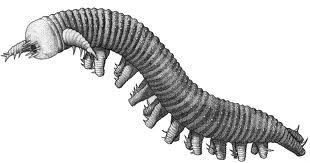- REDIRECT Template:Infobox/arthropod
Aysheaia was a genus of soft-bodied, caterpillar-shaped organisms with average body lengths of 1–6 cm from the Middle Cambrian Burgess Shale. They are maybe Onychophorans along with Hallucigenia. They climb on Vauxias or other sponges. Hallucigenia and Aysheaia are maybe onychophorans.
Discovery
The genus name commemorates a mountain peak named "Ayesha" due north of the Wapta Glacier. This peak was originally named Aysha in the 1904 maps of the region, and was renamed Ayesha after the heroine of Rider Haggard's 1887 novel She. They are known from fossils found in the middle Cambrian Burgess shale of British Columbia, and from the Wheeler Formation in Utah. Similar forms are known from the lower Cambrian Maotianshan shales of China. Aysheaia has ten body segments, each of which has a pair of spiked, annulated legs. The animal is segmented, and looks somewhat like a bloated caterpillar with a few spines added on — including six finger-like projections around the mouth and two grasping legs on the "head." Based on its association with sponge remains, it is believed that Aysheaia was a sponge grazer and may have protected itself from predators by seeking refuge within sponge colonies. Aysheaia probably used its claws to cling to the sponge. Unlike many early Cambrian forms whose relationships are obscure and puzzling, Aysheaia is remarkably similar to a modern phylum, the Onychophora. Other than the 20 specimens from the Greater Phyllopod bed, where they comprise 2% of the community, only 19 specimens of A. pedunculata are known. A. prolata is the species from the Wheeler Formation.

The caterpillar-like animal was the Aysheaia
